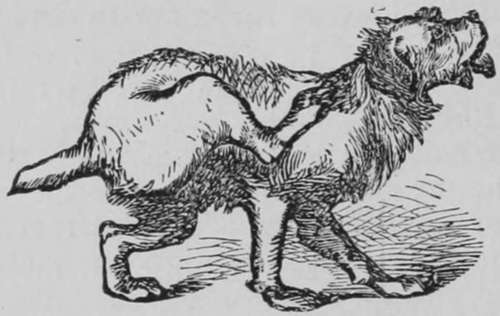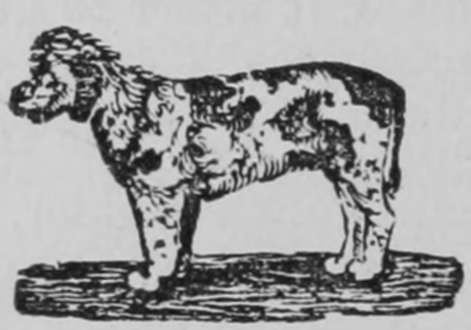Mongrel
Description
This section is from the book "Breeding, Training, Management, Diseases Of Dogs", by Francis Butler. Also available from Amazon: Breeding, training, management, diseases.
Mongrel
Call him Newfoundland, Turnspit, Pointer,
Skye!
Crooked leg, long back, snub nose and bleary eye :
With Setter head, Hound-ear and Terrier-tail! Whilst Pug and Poodle on the whole prevail ! A public nuisance, and the neighbor's pest; His home the gutter, and the street his rest; Nor road, nor path, nor bye way, but reveals Some sneaking Yipyap, skulking at one's heels. Incessant yelps, cries thief by night and day, Put thief in sight, the Mongrel shirks away ; Mocks the faint echo of each canine tone, Yet Hies impromptu, frightened at his own. To title such a despicable brute, Demands a sobriquet, his race to suit; By dogdom doomed, of wit and merit stript, Outcast, plebeian, Mongrel, nondescript, But may exclaim some educated Cur : "Why b!ast our race, by such contemptuous slur?
Pause, pity, ponder thy polluted page, Rude, raving rhymist, rest thy ranting rage ; Among us rare, the Mountebank or Scholar, And rarer yet the Cur, that's worth a Dollar ; Yet treat us well, and train us like a Setter, A Mongrel's word for't;we'd be ten times better."
Harrier, "Barmaid."—An honest representation of an honest hunter. Small, light made and possessing wonderful power of nose, she is able to keep her place in the held, with the best of Foxhounds; often performing miracles in cold weather, when the leading hounds are at fault. Barmaid was never known to overrun her game. Our illustration gives her action, when running at full cry, and will be recognized by many, who have witnessed her performances.
Beagle is the smallest of the Hound Species. They were formerly hunted in packs, but since the introduction of faster stock, their use has been discontinued. He has superior scent and great endurance, and is the best dog in existence for rabbit hunting, on account of his slow pace and diminutive size.
Greyhound (English) is perhaps the most elegant of all the hunting breeds. His speed is supposed to equal that of the fastest racehorse, if thorough bred, he runs wholly by sight, which is superior to that of any other dog. In a coursing match, should he attempt to make use of his scenting powers, he would be ruled off the course, as foul-bred. They require great care and attention in hot climates, as on account of the thinness of their pelts, they are very susceptible of atmospheric changes.


The Mongrels.
Greyhound, Italian, is very similar to the English, but much smaller and too flimsy and delicate, to be of any service in the field, though certainly the most graceful of parlor-pets. Some, when full grown will not exceed 6 or 8 lbs. in weight.
Pointer is much similar to the Setter, in his natural instincts, and equally varies in size and color. He is more suitable than the latter for Sporting in hot weather, on account of his thinner covering. Several countries boast of their celebrated breeds of Pointers. My own opinion is that they are equally good in all latitudes, when they are well trained.
Setter when well bred is a very elegant dog, and deservedly esteemed for his game-hunting propensities. His color, size and appearance vary (like the Pointer) according to the taste and judgment of the breeder, but as three or four shades often appear in the same litter, the idea of color regulating the quality of the an imal, can scarcely be supported. The Setter appears to originate from the Pointer and Spaniel. For hard work and endurance, he may be considered superior to the Pointer.
Water Spaniel is larger than the Cocker Spaniel, his ears are longer and his coat more curly. He is superior to all others for aquatic purposes, and is more particularly serviceable in duck-shooting. His disposition is of the most amiable, and his affection unwavering.
Cocker Spaniel is very much used in England, in Woodcock and Snipe-shooting; is good on all kinds of game, rather inclined to be wild, is more difficult to train than Pointer or Setter. He is little used in the United States, as the method of training him is not generally understood. There is a great variety of so called Cocker Spaniels, varying in weight from 12 to 20 lbs. Their color is generally liver or liver and white. They appear never to tire, where either hair or leather is at stake.
Continue to:
